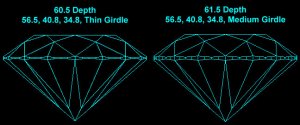Hi Pricescope Experts,
I am looking for a well cut round brilliant diamond, and noticed on the pricescope search engine that most of the diamonds from Whiteflash have a depth percentage of 60.x% compared to most of the other vendors'' depth percentages that vary and go into the 61.x %. Other than depth, how else does this affect the diamond? I''ve also noticed that most of their ACA are consistently (on average) in the 34.8 and 40.8 for crown and pavilion angles, and 55-56% table respectively. How would this compare visually to a 34.5 and 40.8 crown and pavilion angle with a 55-56% table? Thanks for the advice.
Peerless
I am looking for a well cut round brilliant diamond, and noticed on the pricescope search engine that most of the diamonds from Whiteflash have a depth percentage of 60.x% compared to most of the other vendors'' depth percentages that vary and go into the 61.x %. Other than depth, how else does this affect the diamond? I''ve also noticed that most of their ACA are consistently (on average) in the 34.8 and 40.8 for crown and pavilion angles, and 55-56% table respectively. How would this compare visually to a 34.5 and 40.8 crown and pavilion angle with a 55-56% table? Thanks for the advice.
Peerless











300x240.png)